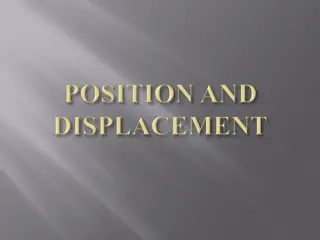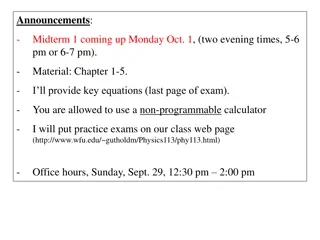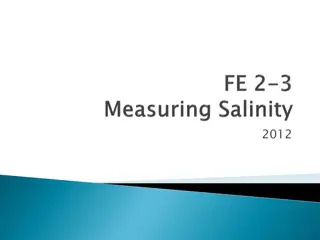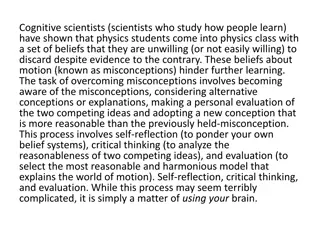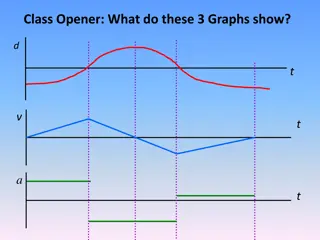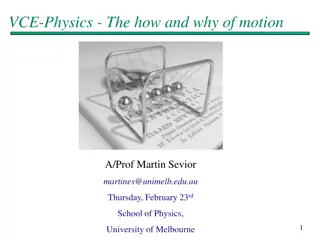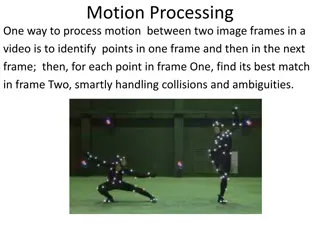Understanding Motion in Physics
Explore the concepts of speed, velocity, and acceleration in physics, learn how to interpret distance-time and velocity-time graphs, and practice calculating the speed and acceleration of objects. Engage in experiments to calculate average speeds and write reports detailing procedures, variables, data collected, limitations, and conclusions. Delve into the relationship between velocity and acceleration when an object changes direction at constant speed.
Download Presentation

Please find below an Image/Link to download the presentation.
The content on the website is provided AS IS for your information and personal use only. It may not be sold, licensed, or shared on other websites without obtaining consent from the author. Download presentation by click this link. If you encounter any issues during the download, it is possible that the publisher has removed the file from their server.
E N D
Presentation Transcript
At the end of this unit you should: 1. Be able to state the relationship between speed, velocity and acceleration. 2. Be able to draw and interpret distance time graphs. 3. Be able to draw and interpret velocity time graphs. 4. Be able to calculate the speed, velocity and acceleration of objects.
acceleration speed distance time distance time graph velocity rate of change velocity time graph
LIGHTBULB QUESTION If a car is travelling at a constant speed and turns a corner (we assume it has not lost speed as it turns), both its velocity and acceleration change. Since the direction of speed has changed (say from east to north to west as in illustration) the velocity has changed. Since the velocity has changed, so has the acceleration.
Speed: The distance an object in one unit of time. It can also be described as the rate of change of distance with respect to time. Unit: metre per second (m/s). Distance: The length of space between two points. Unit: metre (m). Time: A universal unit of measurement through which we measure events in the past, present and future. Unit: second (s)
Investigation 10.02.01: To calculate the average speed of three wind-up toys Equipment: Three wind-up toys, a long, smooth surface and a stopwatch. Instructions: Calculate the average speed of three wind-up toys.
1. How would you make sure this was a fair test? All cars receive the same amount of wind-up. They compete over the same terrain and length of track.
2. Write a report on your experiment. Your report writing should contain the following: Statement of the problem/investigation being carried out; list of equipment; list of variables (independent and dependent); brief description of the procedure carried out; data collected (description and visually); limitations of study (error reporting etc.); conclusions.
3. Which toy was the fastest? Can you explain why? Consider examining the cars to determine what makes the fastest one so fast; for example, is it wheel size, or the length of the car, or the weight?
(a) What is the formula for calculating distance? Speed = Distance/Time. (b) In what units are speed, distance and time measured? Speed is measured in metres per second (m/s). Distance is measured in metres (m). Time is measured in seconds (s).
(c) Would it be a fair test to run 10 m to calculate your average speed for 100 m? Why/why not? No, it would not be a fair test as you are accelerating in the first 10 20 m of any sprint. (d) Calculate the speed of a person walking 100 m in 60 s. 1.67 m/s.
(e) Calculate the speed of a person running 200 m in 24 s. 8.3 m/s. (f) How long does it take a car to travel 7 km at a speed of 14 m/s? Don t forget to convert 7 km into metres. 500 s or 8.3 min.
(g) How far will a person walk in 1 hour if they walk at a speed of 1.5 m/s? Convert 1 hour into seconds (60 min x 60 s) = 3600 s x 1.5= 5400 m or 5.4 km. (h) Calculate the speed of a car travelling 2 km in 45 seconds. Don t forget to convert to SI units. 44.44 m/s. If you want to convert to km/h, multiply by 3 600 (converts seconds to hours) and divide that answer by 1 000 (converts metres to km) = 159.98 km/h.
(i) Calculate the speed of a car travelling 10 km in 15 minutes. Don t forget to convert to S.I. 11.11 m/s. (j) How long does it take a truck to travel 15 km if it has a speed of 80 km/h? Don t forget to convert to SI units. 675.1 s or 11.25 min.
(k) How far can a person get if they run at a speed of 8 m/s for 1 h and 10 min? Convert to SI units. 33 600 m or 33.6 km. (l) Compare the speed of the cars in (h) and (i). Car H is travelling approximately four times faster than car I.
Velocity: Speed in a given direction. Unit: metre per second (m/s).
(a) A person walks north for 190 m. They walk this distance in 24 seconds. What is their velocity? 7.92 m/s north. (b) Calculate the velocity of a rollercoaster if it covers 40 m in 1.5 s. 26.67 m/s. (We do not have a direction to supply as the information is not given.)
(c) Which is faster: this rollercoaster in part (b) or a car covering 1 km in 35 s? What is the speed of this car in km/h? The rollercoaster travels at 26.67 m/s (as per previous questions). The car travels at 28.57 m/s. So the car travels faster. 28.57 m/s x 3600 = 102 857.14 m/h. 102 857.14 m/h/1000 = 102.86 km/h.
(d) A car travels from Dublin to Galway a distance of 210 km in 2 h and 5 min. What is the velocity of the car? Convert to SI units. 28 m/s west.
LIGHTBULB QUESTION Yes, as velocity changes with direction because it is a vector quantity (it has a size and direction).
Acceleration: The change in velocity over time, or the rate of change of velocity with respect to time.
LIGHTBULB QUESTION Speed is not the same as velocity. Since speed does not have a direction, we cannot equate speed and acceleration. We can only equate velocity and acceleration.
(a) Which of these three examples involves acceleration? (i) A car changing its velocity from 10 m/s to 14 m/s. Car is accelerating as there is a change in velocity. (ii) A car travelling at a constant velocity. No acceleration, as no change in direction or velocity. (iii) A car changing its velocity from 14 m/s to 10 m/s. Change in velocity (slowing down), so there is a change in acceleration.
(b) In Table 10.02.02 you will see a list of animals and their top speeds. These are not the speeds of these animals in nature. These are the speeds of the animals if they were the size of a human. Use the table to answer these questions.
(b) (i) Which animal is the fastest? White- throated needletail.
(b) (ii) What animal is the slowest? African bush elephant.
(b) (iii) Explain, in your own words, why you think the mouse is as fast as the cheetah according to the table? The table lists the animals speed if they were all human-sized. So, if they were the same size, a mouse would be as fast as a cheetah.
(b) (iv) Suggest one possible method for calculating the speed of the animals in their natural habitat. State how you would ensure it is a fair test. An observer would have to monitor the animals in their habitat, measure a set distance and time the animals when they run that distance. For it to be a fair test, all animals must run the same distance.
(c) A car starting from rest accelerates to 15 m/s in 4 s. What is the acceleration of the car? 3.75 m/s2.
(d) A car is moving at 27 m/s when it slams on the breaks and comes to a stop 1.2 s later. What is the acceleration of the car? -22.5 m/s2. Note the minus symbol indicates negative acceleration (deceleration).
Table 10.02.04 shows the distance covered by a car starting from rest to 20 s later. (a) Represent the information in Table 10.02.04 in a graph.
(iii) What was the speed of the car at 8 s and 10 s? Explain your answer. At both 8 s and 10 s the speed of the car is 60 m/s. The car is travelling at a constant velocity.
(iv) Give the time taken for the car to reach 800 m. 800 m/60 m/s = 13.33 s.
(v) Is the car accelerating? Justify your answer. Since the car is not changing its velocity (speed) and there is now mention of direction, we can say there is no acceleration.
Tracking a jogger around a field, a graph of their movement can be seen in Fig. 10.02.07. Using this graph, answer these questions.
(iii) In your own words, describe the motion of the runner between 0 10 s. The runner is accelerating from rest to 8 m/s within 2 s. After these two seconds the runner maintains this velocity for 8 s.
(iv) What do we call the motion of the runner between 210 s? Constant velocity.
(v) Calculate the acceleration of the runner between 0 and 2 s. 4m/s2
(vi) Calculate the acceleration of the runner between 10 and 12 s. -2 m/s2. Note the minus symbol indicates negative acceleration (deceleration).
(vii) What is the acceleration of the runner between 18 and 20 s? -5 m/s2.
Analysing DistanceTime Graphs Graph showing an object moving with constant velocity
Analysing DistanceTime Graphs Graph showing an object moving with constant velocity towards its starting point
Analysing DistanceTime Graphs Graph showing an object that is not moving (stationary)
Some graphs, like the one in Fig. 10.02.11, include all three conditions. Tell the story of this graph.
From 0 to 4 s the object is moving at a constant speed. Between 4 and 6 s the object does not move; it stops at 40 metres. From 6 10 s the object is moving at a constant speed back towards the 0 metre mark (start line) (where the object started).
Analysing VelocityTime Graphs Graph showing an object moving with constant acceleration





